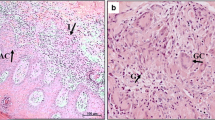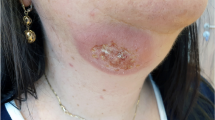Summary
On two patients suffering from Leishmaniasis cutanea from the old world florid and later a residual lesion could be removed for electron-mircroscopic examination, and the following was found:
-
1.
A pseudocarcinomatous follicular epidermal proliferation in the florid lesion.
-
2.
Macrophages with one to three Leishmania cells can be proved in histiocytes nests. The parasites are not always clearly surrounded by host cell membrane.
-
3.
The endocellular Leishmania cells have a ciliary system which is open on the outside. It is, therefore, correct to speak of a cryptomastigotic shape of the flagellum. The kinetoplast shows direct transition to mitochondria. The number of periplast fibrillae or tubuli amounted to 95–97 which is less than in other types of Leishmania. Yet no further morphological distinctive feature between Leishmania tropica and the other types is discernible when a comparison with the pertinent literature is made.
-
4.
No parasites to be considered virulent were found now in the late residual focus of previously secured cutaneous Leishmaniasis. The macrophages, on the other hand, contained big vacuoles with lamellar residual substances. These are regarded as rests of the parasites.
Zusammenfassung
Bei zwei Patienten mit Leishmaniasis cutanea der alten Welt konnten floride und später ein Restherd zur elektronenmikroskopischen Untersuchungen excidiert und dabei folgendes beobachtet werden:
-
1.
Im floriden Herd zeigte sich eine pseudocarcinomatöse follikuläre Epidermisproliferation.
-
2.
In histiocytären Nestern lassen sich Macrophagen mit einer bis drei Leishmaniazellen nachweisen. Die Parasiten sind nicht immer eindeutig von einer Wirtszellmembran umgeben.
-
3.
Die intrazellulären Leishmania-Zellen sind mit einem nach außen offenen Geißelapparat versehen. Deswegen ist es richtig von einer kryptomastigoten Form der Flagelle zu sprechen. Der Kinetoplast zeigt direkten Übergang zum Mitochondrium. Die Anzahl der Periplastfibrillen oder Tubuli betrug 95–97, geringer als bei den anderen Leishmaniaarten. Dennoch läßt sich im Vergleich mit der Literatur kein weiteres eindeutiges morphologisches Unterscheidungsmerkmal zwischen der Leishmania tropica und den anderen Formen erkennen.
-
4.
Im späten Restherd einer früher gesicherten Orientbeule konnten jetzt keine als virulent anzusehenden Parasiten beobachtet werden. Die Macrophagen enthielten dafür große Vacuolen mit lamellären Residualkörpern. Diese werden als Reste der Parasiten angesehen.
Similar content being viewed by others
Literatur
Baum, E.: Die elektronenmikroskopische Struktur des “9+2” Modelles — untersucht am Beispiel menschlicher Spermatozoen und dem Flimmerepithel von Meerschweinchentrachea und Gedanken zur Eigenbeweglichkeit. Dissertation, Bonn 1971
Brack, C.: Elektronenmikroskopische Untersuchungen zum Lebenszyklus von Trypanosoma cruzi. Unter besonderer Berücksichtigung der Entwicklungsformen im Überträger Rhodnius prolixus. Acta Trop.25, 299–332 (1968)
Gargovich, A., Fabrizi, G.: Ultrastructure of Leishmania tropica. 2nd European meeting on electron microscopy applied to cutaneous pathology, Milano, Jan. 17–18, 1975
Garnham, P. C. C., Bird, R. G.: A preliminary study of the fine structure of Leishmania mexicana as seen under the electron microscope. Sci. Res. 1st. Sup. Sanita.2, 83–88 (1962)
Gartmann, H., Kiessling, W.: Hautleishmaniasis in Deutschland. Hautarzt15, 518–521 (1964)
Klingmüller, G.: Über mitgeschleppte tropische Hautkrankheiten. Akt. Derm.1, 167–175 (1975)
Klingmüller, G.: Residualkörper bei lepromatöser Lepra. Arch. klin. exp. Derm.225, 149–162 (1966)
Klingmüller, G.: Tumor of the pilosebaceous tissue. International symposium on biology and disease of the hair, Tokyo, Oct. 6–10, 1975 (im Druck)
McAlpine, J. C.: Electronic cytochemical demonstration of a lysosome in Leishmania donovani. Trans. Roy. Soc. Trop. Med. Hyg.64, 822–825 (1970)
Pham, T. D., Azar, H. A., Moscovic, E. A., Kurban, A. K.: The ultrastructure of Leishmania tropica in the oriental sore. Ann. Trop. Med. Parasit.64, 1–4 (1970)
Piekarski, G.: Heutige Probleme der medizinischen Parasitologie in der Bundesrepublik Deutschland. Bundesgesundhbl.18, 413–418 (1975)
Pinkus, H.: The mesodermal factor in epithelial carcinogenesis. In: Dermatology. Proc. of the XIV international congress, Padua-Venice, 22–27 May, 1972. New York: American Elsevier Publ. Co. 1974
Pyne, C. K.: Etudes sur la structure inframicroscopique du cinétoplaste chez Leishmania tropica. C. R. Acad.251, 2776 (1960) — zitiert von Brack, C.
Rondanelli, E. G., Carosi, G., Cavalcanti, U., Sprovieri, G.: L'ultrastruttura di Leishmania tropica nel bottone d'oriente. Parasitologia13, 333–337 (1971)
Rudzinska, M. A., D'Alesandro, P. A., Trager, W.: The fine structure of Leishmania donovani and the role of the kinetoplast in the Leishmania-Leptomonad transformation. J. Protozool.11, 166–191 (1964)
Sagher, F.: Persönliche Mitteilung
Sanyal, A. B., Sen Gupta, P. C.: Fine structure of Leishmania in dermal leishmanoid. Trans. Roy. Soc. Trop. Med. Hyg.61, 211–216 (1967)
Author information
Authors and Affiliations
Rights and permissions
About this article
Cite this article
Fukuhara, S., Klingmüller, G. Elektronenmikroskopische untersuchungen der leishmaniasis cutanea. Arch. Derm. Res. 255, 305–316 (1976). https://doi.org/10.1007/BF00561501
Received:
Issue Date:
DOI: https://doi.org/10.1007/BF00561501




